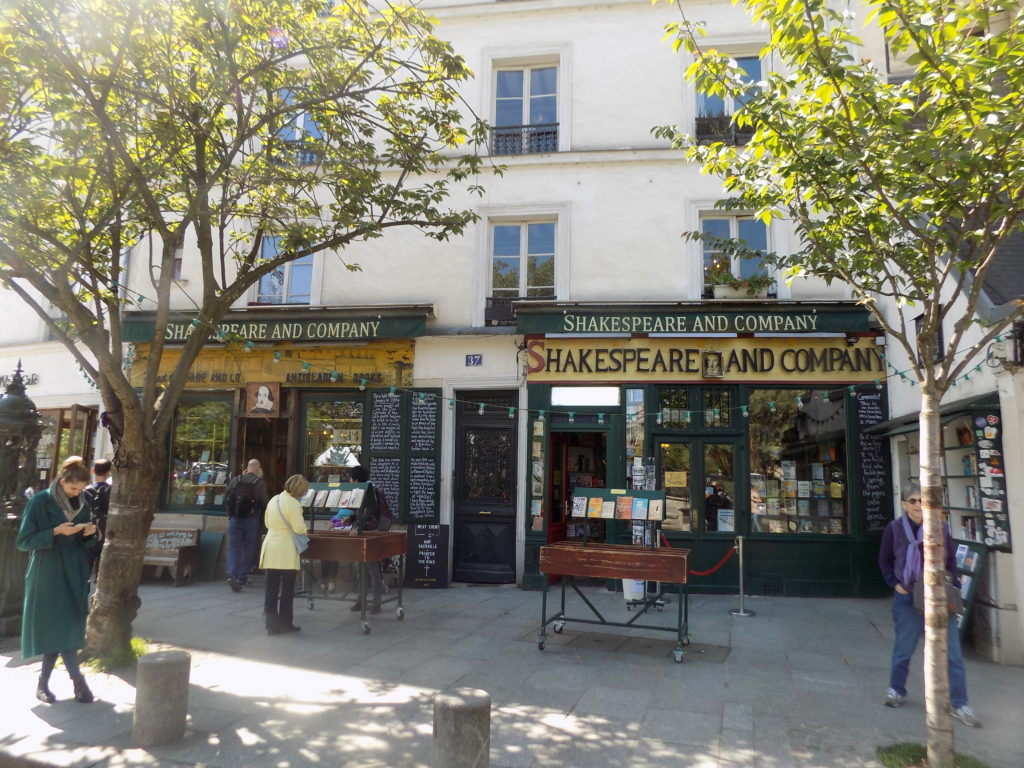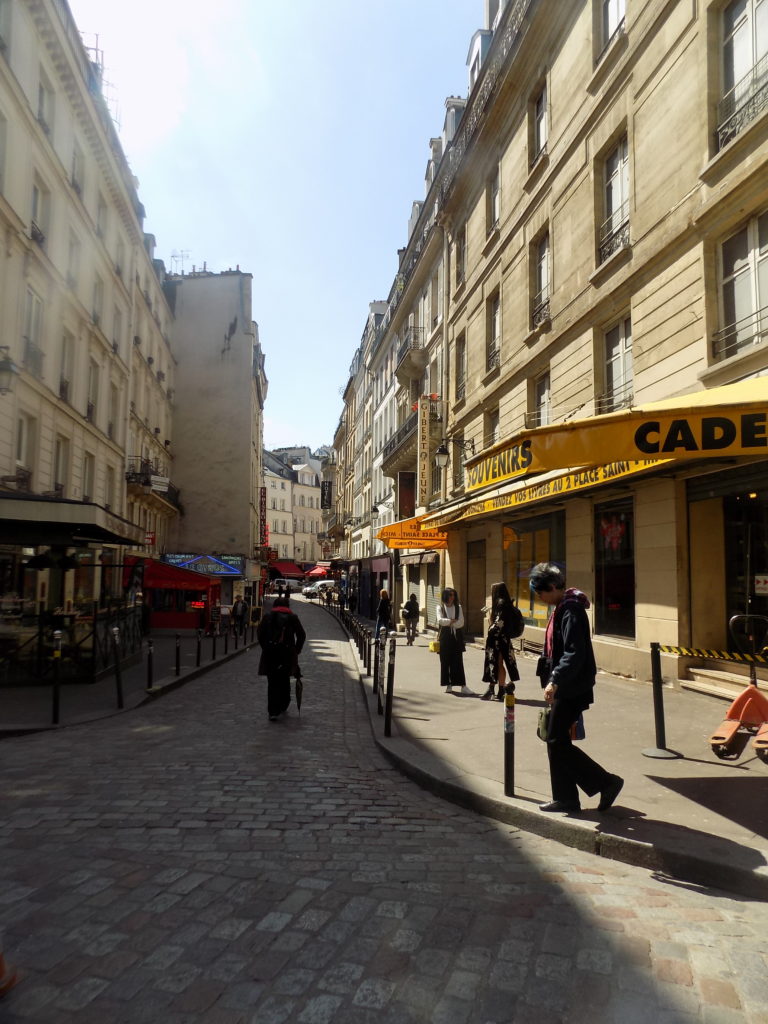When the 18-year-reign of Napoléon III collapsed in 1870 it ended the Second French Empire and gave rise to the Third French Republic. Sprung from rather tumultuous beginnings, France had a period of relative calm beginning at the end of the Franco-Prussian War in 1871 (making my maternal grandmother’s family in Alsace-Lorraine formally German rather than French). Most of Europe’s continental wars then shifted south to Spain or east to the Balkans.
During this period, known as La Belle Époque, a group of “enlightened municipal officials decided to give the families of wounded veterans and war widows the right to leave their boîtes clamped to the riverside walls.” (Downie) in 1891. Notably, the law exempted and continues to exempt them from paying tax for their space. Thus was born the now sprawling spread of nearly 1,000 bouquinistes lining the parapets along la Rive Droite from Pont Marie to Quai du Louvre (now Quai François Mitterrand) and ending just west of rue de l’Amiral de Coligny between the Pont Neuf and Pont des Arts. Or, on la Rive Gauche, you can browse the line of bouquinistes from Quai de la Tournelle to Quai Voltaire (with the last lonely stall just east of Pont Royal) making that two-kilometer stretch of the Seine a veritable bibliothèque de la rivière (river library).
According to Downie, sometime in the 1940’s the regulations specified a maximum permissible length of eight meters of parapet per bouquiniste and, in the 1950’s required the use of the green color called “vert wagon” because it matched old train carriages.
As we were finishing our light meal, one of the booksellers nearby had opened his stand –
a process Downie describes beautifully in Paris, Paris, “The battered boîtes morph into wood-and-tin grasshoppers lifting their legs, or gull-winged vessels carrying precious bundles from the reassuring past toward an uncertain future.”
Books and more books.
Barely 400 meters from where we sat was a bookseller of a different kind. Although a mere toddler compared to the bouquinistes, the shop at 37 rue de la Bûcherie was called “arguably the most famous independent bookstore in the world” in a November 2014 Vanity Fair article. George Whitman, an American in Paris, founded Le Mistral in 1951. It’s now known worldwide by the name he bestowed on it in 1964 – Shakespeare and Company – paying homage to the store founded in 1919 by another American expat, Sylvia Beach.
Beach established her Shakespeare and Company about a kilometer southwest of the present location at 12 rue de l’Odéon. Generally thought of as equal parts bookstore and lending library, the list of writers – both American and French – who frequented the shop is astonishing, including Ernest Hemingway, F Scott Fitzgerald, T S Eliot, Ezra Pound, André Gide, Paul Valéry, and Jules Romains. But women were also drawn to Beach’s shop. One could just as easily find Djuna Barnes, Gertrude Stein, Janet Flanner, Kay Boyle, and Mina Loy there.
Beach also enjoyed a close friendship with James Joyce and, when no one else would publish his Ulysses, she bravely did so in 1922. She closed her shop in 1941 when the Nazis occupied Paris and spent six months in a detention camp at Vittel for her defiance. The woman who Hemingway described in A Moveable Feast as having, “a lively, sharply sculptured face, brown eyes that were as alive as a small animal’s and as gay as a young girl’s” never reopened her shop.
According to the store’s website, Whitman said, “I created this bookstore like a man would write a novel, building each room like a chapter, and I like people to open the door the way they open a book, a book that leads into a magic world in their imaginations.” In some ways, Whitman carried on the tradition Beach established and a new generation of expat American writers including Allen Ginsberg, William Burroughs, Anaïs Nin, Richard Wright, William Styron, Julio Cortázar, Henry Miller, William Saroyan, Lawrence Durrell, James Jones, and James Baldwin quickly found their way to his shop.
Whitman did more than simply welcome them. Adhering to a philosophy he expressed as, “Be not inhospitable to strangers lest they be angels in disguise,” they had a standing invitation to spend the night. In return, he asked that they read a book a day, help at the shop for a few hours, and write a one-page autobiography.
Another writer who spent time at Shakespeare and Company is also an actor – Ethan Hawke. Fans of the “Before” Trilogy will recognize the exterior as the store where Jesse and Celine (Hawke and Julie Delpy) reunite in the opening scenes of Before Sunset. The image of Hawke at the bottom of the frame taken from the trailer was shot in the store. (I highly recommend all three films for those who don’t know them.)
One last lovely fact before I move on. In 2006, Whitman, then 93, gave control of the store to his daughter. He announced his retirement by writing on the store’s shutters, “Each monastery had a frère lampier whose duty was to light the lamps at nightfall. I have been doing this for fifty years. Now it is my daughter’s turn.” Her name is Sylvia Beach Whitman.
-ests seen and missed.
If you look closely at the photo of Shakespeare and Company, you can see a partly obscured Pat behind the tree on the right. Several hours remained before we were to meet Celeste at the flat and Pat was walking west. We’d only walked a block or so when we turned left onto rue du Petit Pont. A block farther we came upon what struck me as an interesting looking church
so I snapped a quick photo. The church is Saint-Séverin and plays no role in this narrative. What is important is the small sign attached to the fence in the bottom center of the picture. The sign reads “RUE SAINT JACQUES”. Had my memory of David’s book been keener, I’d have recalled that rue Saint-Jacques is the oldest street in Paris. This was the first of the seen but missed -ests.
(You might remember that writing about Bayeux I answered a friend’s question concerning my most surprising discoveries on my travels and I’d responded that it was finding unexpected connections. In some ways, it’s unsurprising to connect one event or sight on a single trip with another on that same journey. In other ways, it remains surprising. So please keep this brief crossing of rue Saint-Jacques in mind because it will connect not only to the final day of this trip but indirectly to my October 2017 trip to Spain.)
Meanwhile, had we but known or even if we’d turned right instead of left when leaving Shakespeare, we could have walked along rue Saint-Julien-le-Pauvre and reached the same spot. However, had we taken that route, we would have passed that saint’s namesake church. In the small park adjacent to that church stands le plus vieil arbre de Paris – the oldest tree in Paris – a fact I discovered long after my return to the U S while doing post trip research trying to learn the name of the church in the above photo. The tree in question is a locust tree imported from America and planted by the Royal Gardener in 1601. Yet another nearby and unseen -est.
We continued wandering aimlessly until we reached the Fontaine Saint-Michel (Saint Michael Fountain) one of the signature projects of Baron Georges-Eugène Haussman who, for better or for worse (certainly my friend David thinks for worse), remade Paris during the reign of Napoléon III. Haussman’s disquiet would be the counterweight to David’s joy and pleasure wandering the narrow winding streets.
In 1855 Haussman completed one of his major projects, a north-south boulevard running parallel to rue Saint-Jacques just a block to the east. Originally called boulevard de Sébastopol-rive-gauche, it’s now the boulevard Saint-Michel.
Haussman, whose baronial title was granted honorarily but never officially by Napoléon, asked the architect Gabriel Davioud to design and construct a fountain appropriately scaled to the enlarged place in front of the Pont Saint-Michel. Work began on the fountain in 1858. Completed in 1860, this is the result.
Thus far we’d probably walked about two-and-a-half kilometers and, with our mid-morning meal had pushed far enough into the day that we agreed it was time to find our way back to the flat. However, before I lead you back across the Pont Saint-Michel I’ll point to one other left bank oddity that had, at some point during our walk, floated into my peripheral vision and caused me to stop just long enough to take a photo.
In my post trip research, I inadvertently happened upon a website that named the narrowest street in Paris. When I saw the name, it triggered a memory that sent me scrambling through my pictures. And, indeed, there it was – rue du Chat qui Pêche – literally the street of the Cat who Fishes. More colloquially, Fishing Cat Street. Looking more like a passageway or an alley, it’s officially listed as a street. Another seen and unseen -est.






